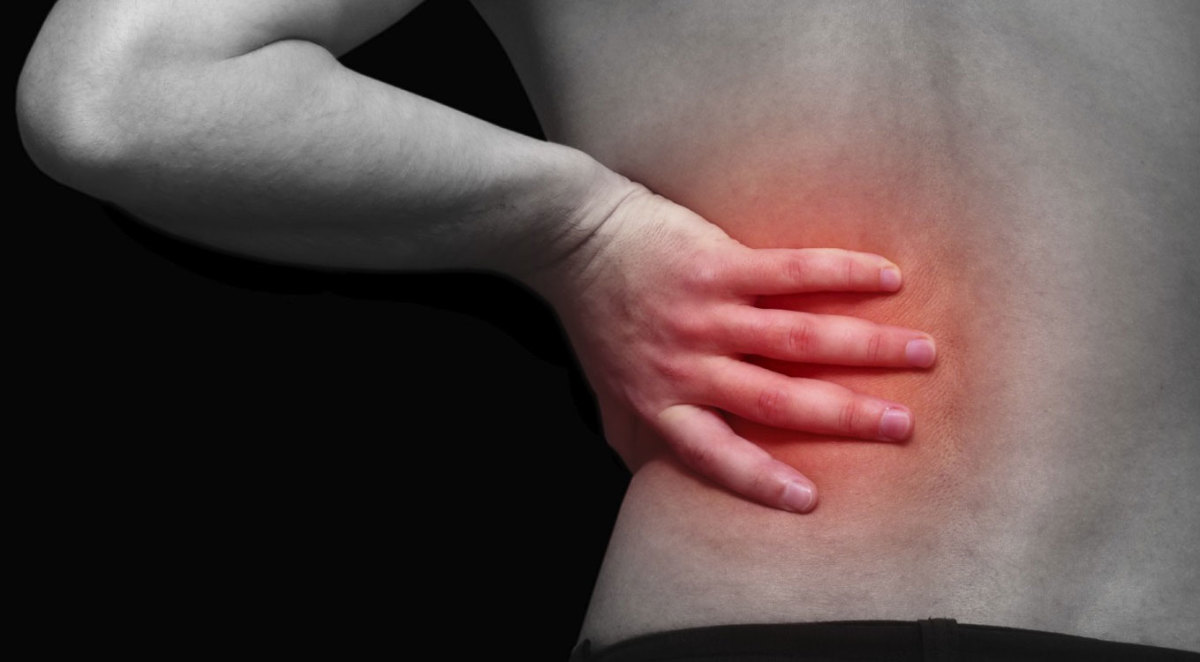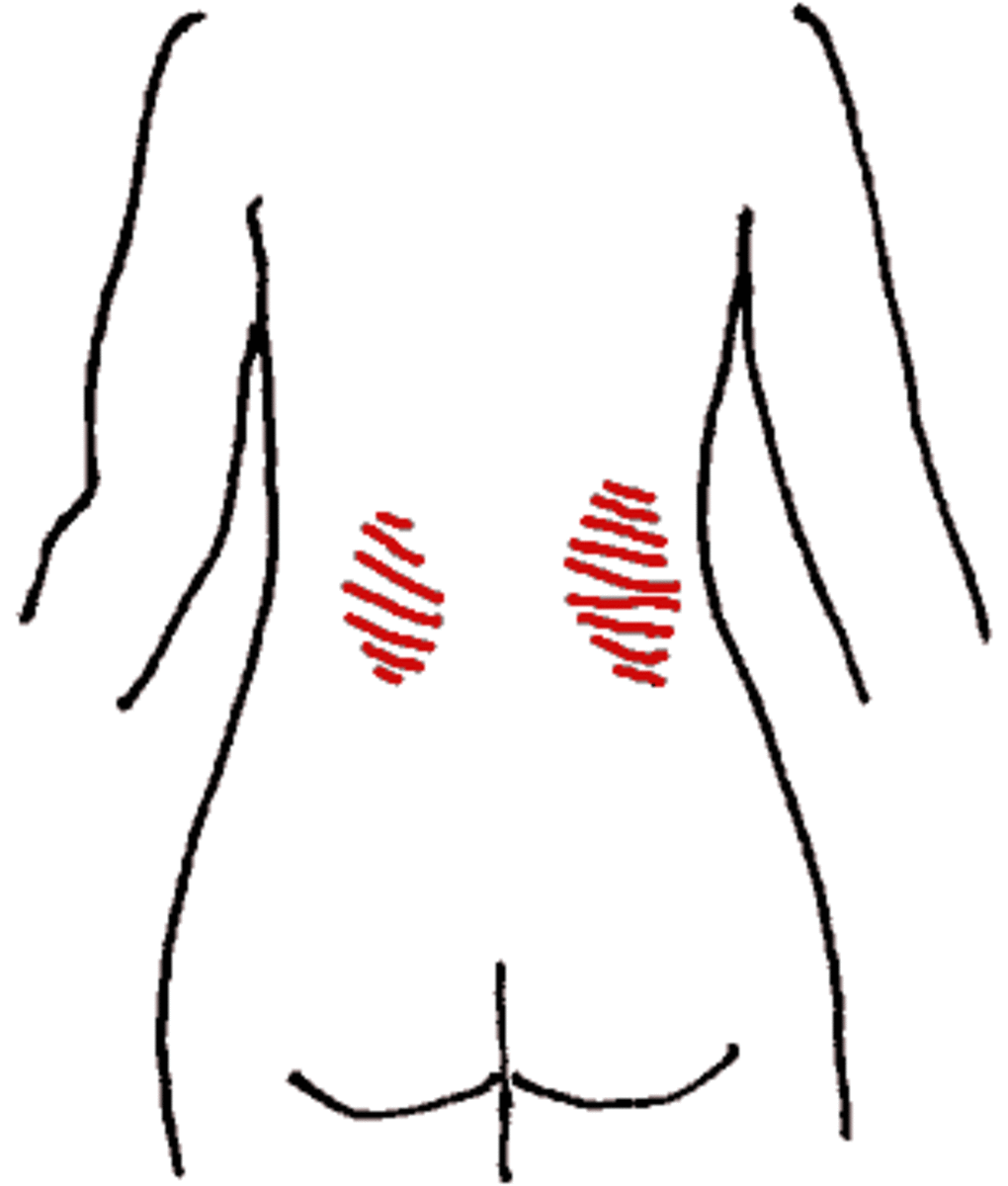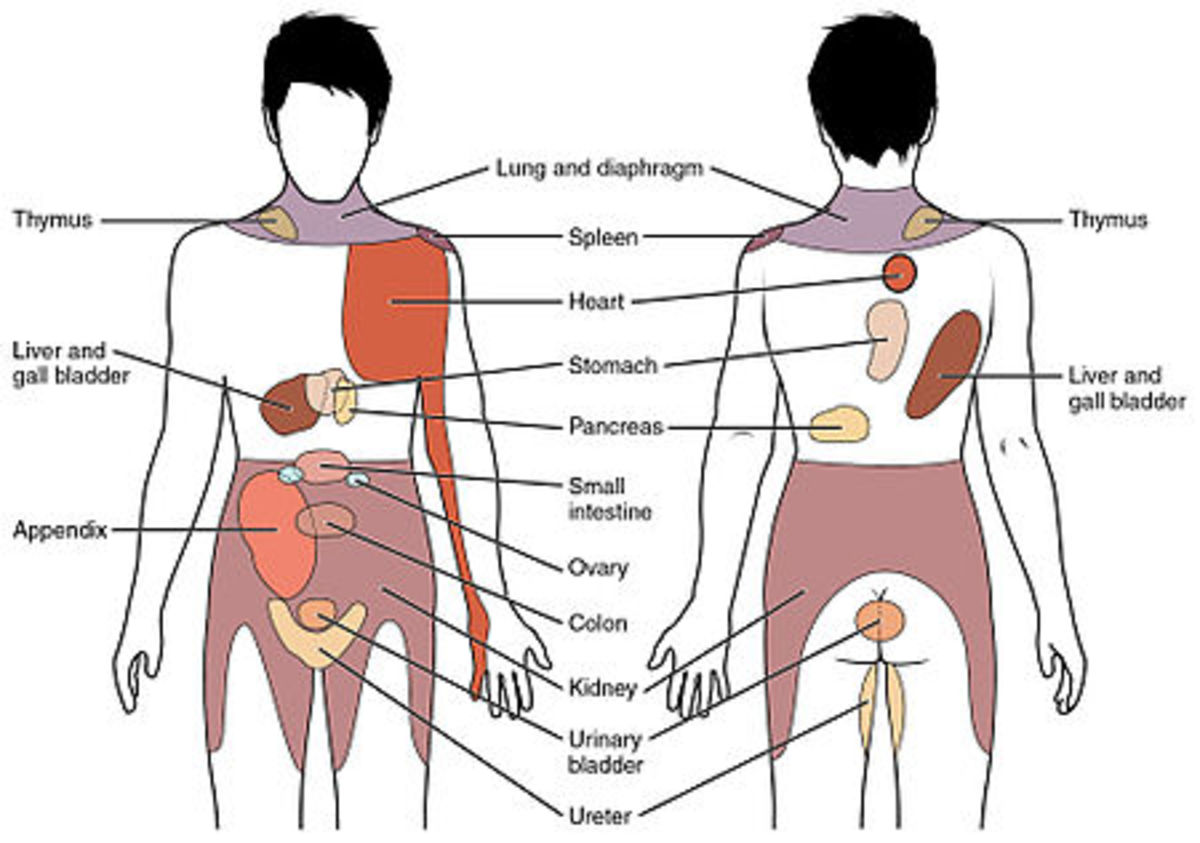Kidney Pain: 10 Causes with Symptoms





Kidney Pain

Typical kidney pain location | Source
Kidneys Location

The position of the kidneys | Source
Kidney Pain Location
Kidneys are located at the bottom of the rib cage, about 3 inches away from the spine on each side (see the image on the right), but the pain from the kidneys can be expected over much larger area of the middle back and side of the body--in the flanks (see the image above).
Some kidney disorders are rarely associated with pain, for example, chronic kidney failure.
Some kidney disorders cause no spontaneous pain, but pain can be provoked by a gentle hit to a kidney by the bottom of the fist.
Referred Kidney Pain

Pain from the chest and abdominal organs can radiate to distant parts of the body. | Source
Pain from the kidneys can radiate to a wide area of the middle and lower back and abdomen, groin and thighs (see the light brown area in the picture above). This is so called referred pain. Urinary stones in the kidneys or ureters are the most common cause of referred kidney pain.
Symptoms and Signs Associated With Kidney Pain
Symptoms of kidney disorders typically associated with kidney pain:
- Nausea or vomiting
- Cloudy or foamy urine or smelly urine
- Passing a stone in urine
- Frequent urination
- Excessive urination (increased total daily amount of urine)
- Blood in urine
- Anorexia
- Fever or chills
- A lump in the flank or in upper abdomen
- Generalized itch or rash
- Generalized body swelling
Common Causes of Kidney Pain
- Kidney stones
- Kidney inflammation (nephritis)
- Kidney infection (pyelonephritis)
- Obstruction of the ureteropelvic junction (UPJ)
- Kidney enlargement (hydronephrosis)
- Loin pain hematuria syndrome (LPHS)
- IgA nephropathy
- Kidney tumor
Kidney Stone Pain

Typical distribution of kidney stone pain | Source
1. Kidney Stones
Kidney stones are formed in the kidneys but they usually cause pain only when they lodge in the ureter on the right or left side.
Pain from the kidney stone presents as a severe pain in the flank that can last from several minutes to few hours and can radiate down by one side of the lower back or abdomen into the groin and genitalia.
The pain can recur in intervals of different lengths -- from days to months. A small stone can be sometimes excreted in the urine.
Other symptoms may include nausea, vomiting, frequent urination, cloudy urine, and blood in urine.
Uncomplicated kidney stones are usually not associated with fever.
Over the counter painkillers, such as aspirin or paracetamol can help relieve the pain.
2. Kidney Inflammation
The cause of kidney inflammation (glomerulonephritis or interstitial nephritis) is often not known. Symptoms may include:
- Acute or chronic, mild, dull pain in one or both kidneys with a waxing an waning course (the pain can be absent)
- Foamy urine
- Swelling around the ankles and around the eyes or generalized swelling
- Low-grade fever
Treatment may require steroids or other anti-inflammatory drugs.
3. IgA Nephropathy
IgA nephropathy or Berger's disease is a type of kidney inflammation.
Symptoms:
- Brown, cola- or tea-colored urine, usually triggered by a respiratory or gastrointestinal infection
- Spasms or dull pain in both flanks
- Symptoms may last for up to 3 days.
4. Kidney infection
Kidney infection (pyelonephritis) usually arises from the infection of the lower urinary tract (urethra or bladder).
Symptoms:
- Pain in one or both flanks
- High fever and chills
- Nausea
- Burning urination
- Cloudy and smelly urine
- Blood in urine
Treatment is by antibiotics.
5. Obstruction of the ureteropelvic pelvic junction
Obstruction of the ureteropelvic junction (UPJ) refers to narrowing of one or both ureters at the point where they leave the kidneys.
The main symptoms are sudden pain in one or both flanks after drinking large amounts of fluid.
Prevention is by avoiding drinking large amounts of fluids in a short time. Usually, no treatment is required.
6. Kidney Enlargement
Kidney enlargement (hydronephrosis) can be caused by the obstruction of one or both ureters, usually by a kidney stone or tumor. The enlargement can develop quickly, within few days, or gradually over several moths.
Symptoms include a lump and dull pain over the kidney on one or both sides.
A sudden kidney enlargement is a medical emergency. Treatment may involve endoscopy or surgery.
7. Loin Pain Hematuria Syndrome
Loin pain hematuria syndrome is a rare kidney disorder caused by infection, hormonal changes or use of oral contraceptives, mainly in young women.
Symptoms may include:
- Constant or throbbing pain in one or both flanks, aggravated by exercise
- Blood in the urine
- Fever
- Symptoms may last from hours to months and often recur.
Polycystic Kidney Disease
Polycystic kidney disease is a hereditary disease with cysts in both kidneys.
Symptoms:
- Middle back or upper abdominal pain
- A palpable lump in the upper abdomen on both sides
- Increased blood pressure
- Occasional blood in urine
- Frequent urinary infections
9. Vasculitis
Inflammation of the arteries (vasculitis) can also affect kidneys. This can happen in diseases, such as polyarteritis nodosa or Henoch-Schönlein purpura.
Symptoms:
- Bilateral kidney pain
- Skin rash
- Low-grade fever
10. Kidney Tumor
Kidney tumors (benign or malign) can develop in any life period.
Symptoms may include:
- Slowly progressing pain in the kidney area, usually only on one side
- Blood in urine
- Poor appetite
- Unintentional weigh loss
- A lump in the kidney area
Treatment is by chemotherapy or surgery.
Kidney Stone vs Infection vs Inflammation
Kidney Stone
|
Kidney Infection
|
Kidney Inflammation
|
|---|---|---|
Sudden, severe pain in the flank radiating to groin
|
Throbbing pain in the flank
|
Sometimes, dull pain in the flank
|
No fever
|
High fever
|
No or low-grade fever
|
Clear urine
|
Cloudy and smelly urine
|
Sometimes, foamy urine
|
Nausea
|
Nausea, vomiting
|
Sometimes, rash
|
Kidney Pain and Other Causes of Lower Back Pain

Source
The following conditions can mimic kidney pain:
- Muscle strain in the lower back
- Fibromyalgia
- Peptic ulcer
- Appendicitis
- Disorders of the spine (ankylosing spondylitis, osteoporosis), spinal nerves (pinched nerve, shingles), spleen, liver (hepatitis), pancreas (pancreatitis), gallbladder (gallstones), colon (trapped gas), abdominal aorta (an aneurysm), lungs (pneumonia), lung membrane (pleurisy)
Most of the above conditions do not cause any acute changes in the frequency of urination or in urine color.


















No comments